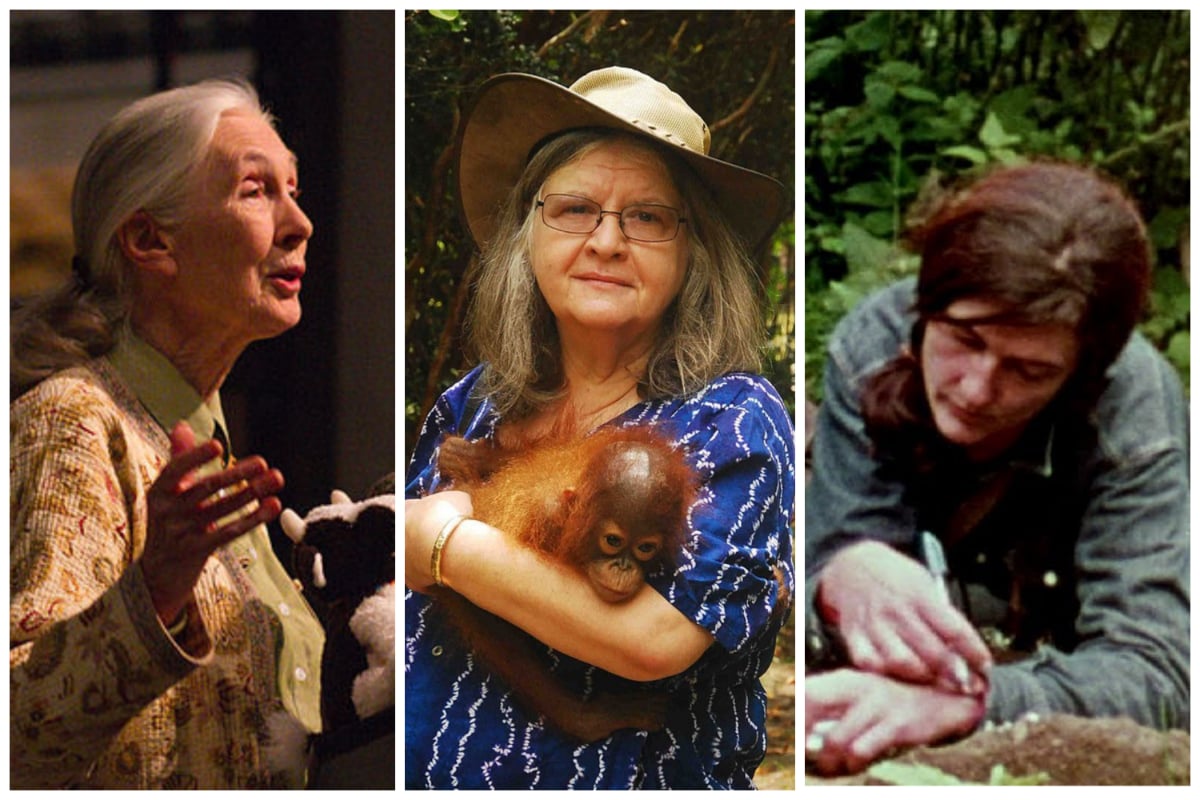Technology and science have advanced quickly in the last fifty years. We are worrying about AI taking over creative spaces when we only really discovered how humans evolved in the 1940s-1970s. There were theories before then, but skeletal remains creating a physical map weren’t found until relatively recently. Paleoanthropologists named Lucy, our first bipedal ancestor, after The Beatles’ song “Lucy in the Sky With Diamonds” since it was playing when they discovered her.
To better understand our ancient ancestors, paleoanthropologist power couple Louis and Mary Leakey thought scientists should study our great ape cousins. Chimpanzees, gorillas, and orangutans could provide clues to how humans once lived. Enter the Trimates, three female scientists dispatched by the Leakeys who would study these apes and make science history.
Jane Goodall: Chimpanzees
Most people have probably heard of Jane Goodall. At the age of 88, she’s still an environmental activist. Her work as the first of the Trimates began in July 1960. After studying primatology, Goodall (with her mom as her chaperone) set up her research at Gombe Stream National Park in Tanzania. Goodall engrained herself with a troop of chimps and lived as one of them for about 22 months. She shared food and grooming rituals with them.
When she documented her research, male scientists scoffed at her methods. Goodall went against tradition by interacting with the animals and giving them names (instead of numbers). Even though her methods may have been controversial, her discoveries rocked the science world. Scientists had long-held beliefs that chimps were vegetarian and docile. Goodall documented chimps eating insects and hunting small monkeys, along with some instances of cannibalism. Chimps can be aggressive and “warlike,” but Goodall also documented how caring they were towards others in their troops. They used very human-like gestures such as hugging and patting each other on the backs.
Before Goodall, the entire scientific community held that one thing set humans apart from other animals—the ability to make and use tools. During her time with the chimps, Goodall witnessed them using grass and sticks as tools to get termites out of their mounds. Instead of eating the bugs one by one, the sticks allowed the chimps to eat mouthfuls of termites at one time. This one discovery changed everything about how scientists saw humans.
Dian Fossey: Gorillas
After auditing a primate class for eight months and spending some time with Goodall, Dian Fossey started her research on gorillas. In 1967, Fossey set up her campsite deep in the Virunga Mountains that run the border of Rwanda, the Democratic Republic of the Congo, and Uganda. To get close to the gorillas, who had only encountered poachers, Fossey would act like them until they felt comfortable around her.
As the first person to study gorillas for an extended time, Fossey discovered the types of calls gorillas make, how intergroup dynamics work, and how they form a nutritional cycle with their environment. She found gorillas are mostly gentle and social animals with some territorial behavior. They form strong bonds within their groups and will fight to the death to protect their young from poachers. Fossey identified different gorillas by their unique “nose prints.”
After Fossey’s murder in 1985, she was buried next to her beloved gorilla Digit who had been killed by poachers years earlier. The Karisoke Research Center she founded still survives to this day. Other researchers carry on her legacy of research and gorilla protection. In more recent years, the center has made huge strides in keeping the gorillas safe from poachers and empowering the local communities to aid in these efforts.
Biruté Galdikas: Orangutans
Inspired by the work of Goodall and Fossey, Birutė Galdikas studied primatology and petitioned Leakey to help her set up a study of orangutans. In 1975, Galdikas began her research. At the Tanjung Puting Reserve in Indonesian Borneo performed the first full-length study of orangutans. Prior to Galdikas’ research, almost nothing was known about orangutans. Called the “mother of orangutans,” she was once featured on an iconic cover of National Geographic holding the hand of one orangutan while cradling another like a baby.
Through her research, scientists know what orangutans eat and how their social structures work. Galdikas also took captive orangutans and successfully reintroduced them to life in the wild. She still works to preserve land in Indonesia to save the apes she studied. Sadly, orangutans are a threatened species. This mainly non-aggressive ape has been nearly wiped out to extinction due to palm oil production, logging, and fires.
Research techniques have drastically changed since Goodall, Fossey, and Galdikas started their missions. Giving the animals names changed how we perceive them. Without their methods, animal research would not be what it is today. These trailblazing women inspired many other women to enter science-related fields, especially primatology. My youngest kid wants to go to Africa to study chimps, “just like Jane.”
(featured image: Mark Schierbecker, CC BY-SA 4.0 via Wikimedia Commons/Simon Fraser University – University Communications, CC BY 2.0 via Wikimedia Commons/screencap)









Published: Mar 27, 2023 04:59 pm